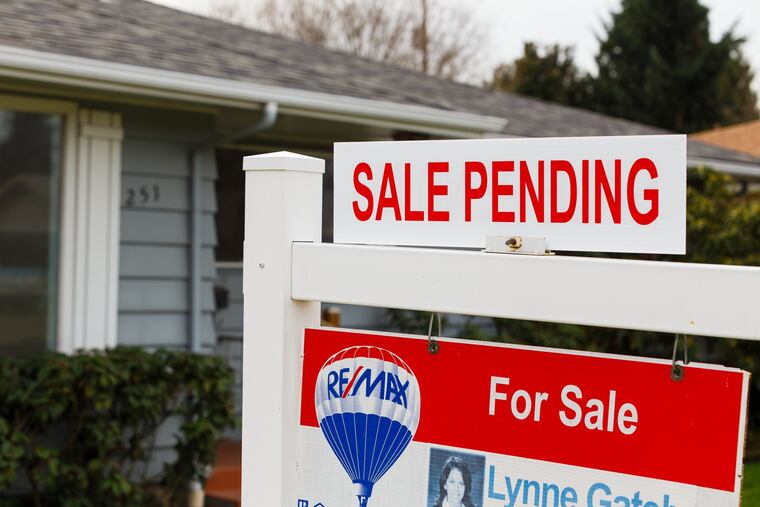Hot housing prices may cool amid rising mortgage rates
House prices are set to return to earth pressured by rising mortgage rates.

If you are fortunate enough to own your home, it has been a banner year. A banner decade, really. House prices have gone stratospheric almost everywhere, including in the Philadelphia region.
Don’t get too giddy. House prices are set to return to earth. Indeed, you might want to visit the Zillow website to check out that service’s estimated value of your home. It may be the last time you see that high a price for your home for a while.
The nationwide median price for an existing home that sold last month was almost $400,000. That’s up more than $50,000 or 15% from a year ago and $220,000 or 130% from a decade ago.
These are big numbers. They are even more outsized when you consider that the typical first-time homebuyer puts up a downpayment equal to only about 10% of the home’s purchase price. If you were that homebuyer a decade ago, the annualized return on your home investment today would be an eye-popping 37%. Your investment would have increased by more than one-third each year on average for 10 years.
» READ MORE: Foreclosure activity nationally and locally has hit pandemic highs but is still below normal
Consider that if that homebuyer had put money into the stock market, say an S&P 500 index fund, the total annual return would have been about 15%. Not too shabby, but not in the same league.
Sure, there are many costs involved in owning a home, such as maintenance, taxes, and utilities. However, there are lots of benefits to living in a nice home in a nice neighborhood. These costs and benefits probably balance out. The bottom line is that owning a home in recent years has been a slam-dunk financial windfall.
But housing’s salad days are over. House prices will be lucky to hold their own for the next few years. What changed? The answer is mortgage rates. They have risen a lot in recent weeks. Thirty-year fixed mortgage rates surged to more than 5.25%, up from 3% as recently as the start of the year. They were down to 5.1% in Thursday’s weekly report. For much of last year, rates consistently hit new record lows well below 3%.
Even higher mortgage rates seem likely. The economy is growing strongly, and inflation is raging, forcing the Federal Reserve to go on high alert. It is telegraphing numerous interest-rate hikes.
Higher mortgage rates have quickly conflated with the extraordinarily high house prices to make purchasing a home unaffordable for most Americans. At the current mortgage rate and house price, the monthly mortgage payment is more than $1,700. That’s $500 more a month than a year ago, almost $1,000 more than a decade ago in today’s dollars. A household earning the median income needs to shell out almost a third of its income for the monthly payment.
This daunting arithmetic is quickly creating fissures in the all-important spring home-selling season. Mortgage applications to purchase a home and buyer traffic for new homes have rolled over definitively. With home sales under pressure, the parabolic increase in house prices will soon peter out. Prices are likely to decline meaningfully in markets, mostly in the South and West, that have been most juiced-up. Philadelphia isn’t one of these markets, but it won’t be spared some price weakness.
Of course, talk of house-price declines conjures up the nightmare of the bursting housing bubble and financial crisis more than a decade ago. That’s not what is going to happen this go-around. The crash occurred in no small part due to the egregious mortgage lending and inherently unaffordable loan products that drove housing demand during the bubble. Remember those two-year subprime exploding adjustable-rate mortgages. Mortgage defaults and foreclosure sales at significantly discounted prices surged when the market crashed back then.
Financial system safeguards put in place in the wake of the financial crisis, including new rules on mortgage lending, have made lending far more restrained in the current house-price boom. Today mostly only 30- and 15-year fixed rate mortgages are being originated. Foreclosures are sure to rise in the next few years, but only modestly in a return to more typical levels and certainly not to the degree that would result in more serious price declines.
Also putting a proverbial floor under house prices is the severe shortage of homes. Ever since homebuilding collapsed during the housing crash, builders have been unable to put up enough new homes. The pandemic has also scrambled supply chains for building materials, delaying deliveries of everything from plumbing fixtures to countertops.
So even though eye-popping house-price declines are unlikely, brace yourself. House prices are going nowhere fast in the next few years. It will be quite a comeuppance.
Mark Zandi is chief economist of Moody’s Analytics.